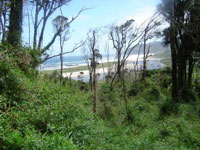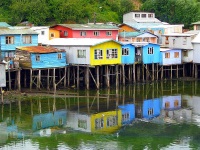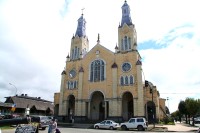Things to do in Isla Grande de Chiloe
This mystical island remains a reasonably undiscovered gem for travellers in Chile and there is still lots to discover. The island has remained remote and isolated for centuries and, as a result, has retained a unique and intriguing culture with a rich folklore that delights visitors. Although travellers may not find as many traditional tourist attractions here as they might in other regions, they will certainly be charmed by the landscape and culture of Isla Grande.
Castro, the capital, is quaint and colourful and just wandering the streets and taking in the unique architecture and culture is invigorating. There are several sightseeing attractions, including some great craft markets, the San Francisco Church, the regional museum and the MAM Gallery. As with many Chilean cities, the Plaza de Armas (central square) is a good starting point.
One of the most special attractions of Isla Grande de Chiloe is the collection of 17th-century wooden churches strewn about the island. These churches remain perfectly preserved and have been jointly declared a UNESCO World Heritage site. The architecture of these buildings is unique and their various settings are astounding and often quite spooky.
Isla Grande is also the base for excursions out into the archipelago and can be used as a pathway to a number of beautiful wilderness areas. The undisputed jewel among these is the nearby Parque Nacional Chiloe, which boasts stunning natural landscapes and a number of well-maintained hiking trails.

Parque Nacional Chiloe
Following in the footsteps of 19th-century English naturalist Charles Darwin, visitors will find an isolated but wildly beautiful landscape of rolling hills, native forests and pri…
Parque Nacional Chiloe
Following in the footsteps of 19th-century English naturalist Charles Darwin, visitors will find an isolated but wildly beautiful landscape of rolling hills, native forests and pristine coastline in Parque Nacional Chiloe. It is home to the Chilote fox, the rare pudu (miniature deer) and over 100 species of birds, including the Magellanic penguin.
The park offers a variety of walking trails, through forests and under twisted tepu trees, along miles of unspoilt coastline or along nature trails that lead up onto the hills for superb views of the surrounding area. One of the draws of the hiking trails in Chiloe is the wide selection of short hikes, making it a good activity even for novice hikers, but there are also epic hikes for those who want to walk long distances. The park is also home to several Huilliche Indian communities, and visitors can find information about the traditions and folklore of the Huilliche people, as well as displays on the flora and fauna of the area.
This amazing wilderness area is only 18 miles (30km) west of Chonchi and 34 miles (54km) west of Castro, making it easily accessible. The area receives a huge amount of rain year round, so visitors should be sure to come prepared.
Website www.gochile.cl/en/chiloe-national-park/

Castro
Founded in 1567, Castro is the main town (technically a city) on Chiloe Island and the third oldest city in Chile. It's famous for its colourful rows of palafitos (stilted houses) …
Castro
Founded in 1567, Castro is the main town (technically a city) on Chiloe Island and the third oldest city in Chile. It's famous for its colourful rows of palafitos (stilted houses) lining the estuaries, excellent seafood and traditional handicrafts. With an eclectic blend of Chilote culture and modern development, Castro is a popular summer destination for both Chilean and Argentinian tourists and has a laid-back feel to it.
One of the town's most interesting features is the San Francisco Church. Painted in dazzling pastel colours, it contains a number of other interesting attractions, including craft markets, the regional museum and the MAM Gallery. Castro also has a range of restaurants and shops, and a few bars to keep the fun going into the night. The central town square, Plaza de Armas, is the heart of Castro, where visitors will find a number of great eateries, as well as a prime people-watching position.
Cycling around the island is another popular activity and a good way to see the sights. The town is also a short hop away from the nearby islands of the Chiloe archipelago and the Parque Nacional Chiloe, which make for wonderful excursions.

Wooden Churches of Chiloe
The Spanish, who arrived in the 16th century, and Jesuit missionaries that came to Isla Grande de Chiloe in the 17th century, built hundreds of wooden churches in the archipelago i…
Wooden Churches of Chiloe
The Spanish, who arrived in the 16th century, and Jesuit missionaries that came to Isla Grande de Chiloe in the 17th century, built hundreds of wooden churches in the archipelago in an attempt to 'civilise' the three local Indian tribes that occupied the islands. The Jesuits built more than 80 of these places of worship, and the Franciscan order later joined them and added to the region's astounding collection of chapels and churches. The 16 churches that still remain well preserved have been jointly UNESCO-listed. Visiting some of these old buildings is one of the most interesting things to see and do in Isla Grande de Chiloe.
Apart from being ancient, the churches have a unique architecture that makes them special; in fact, the whole archipelago benefits from its own style of building, which visitors find delightful. Although recognisably colonial in some ways, the mix between the local and European influences is unexpected and original to the area, possibly because isolation allowed the architectural style to develop largely undisturbed for centuries. The churches are wooden, often painted with the pastel colours associated with Castro.
Three of the most famous can be found in the villages of Chonchi and Dalcahue, and in Castro itself. They're a popular tourist attraction in Isla Grande de Chiloe, and those lucky enough to travel to this region should try to visit as many as possible.



